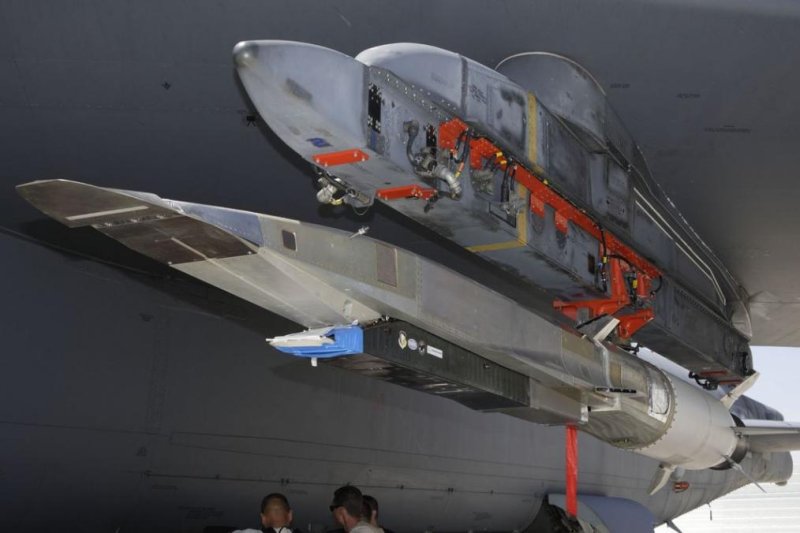A U.S. Air Force X-51A WaveRider hypersonic test missile is seen beneath the wing of a B-52 bomber. Photo courtesy of U.S. Air Force
Oct. 15 (UPI) -- Deployment of a long-range hypersonic weapon system by the U.S. Army is expected by 2023, the Association of the United States Army was told at its annual convention.
Robert Strider, deputy director of Army hypersonic programs on Monday told attendees of the AUSA convention that an experimental prototype, "with residual combat capability," will be fielded by 2023, as announced by the Army last month.
"Those words are tattooed on every one of us within the rapid capability and critical technologies office," Strider said. "The booster that we'll use to launch it will be absolutely common with the Navy. In fact, there's a [memorandum of agreement] in place that put the Navy in charge of design and the Army in charge of production."
Strider added that a battery of eight missiles launched from a mobile ground platform will be capable of breaking speeds of Mach 5 -- about 3,800 mph on land -- and that the hypersonic weapons system leads the Army's list of priorities.
In June, the Army announced it plans to test a prototype in 2020.
Hypersonic missiles will be capable of reaching the top of the Earth's atmosphere, remaining beyond the range of air and missile defense systems, until they are ready to strike. They will be designed for accuracy, speed, survivability and maneuverability, according to the Army, and can strike anywhere in the world within minutes.
Design of the missiles and the launching platforms is overseen by the Army's Rapid Capabilities and Critical Technologies Office, whose focus has been on hypersonic devices since 2018.
The missile's construction includes a Common Hypersonic Glide Body, modified trucks and trailers and existing command-and-control technology. Dynetics Technical Solutions of Huntsville, Ala., has been contracted to manufacture C-HGB prototypes.
Lockheed, Raytheon and Boeing also have contracts with the Missile Defense Agency to design a hypersonic missile defense system.
There are two possible impediments to execution of the program, Eric Sherff, Lockheed's vice president for hypersonic programs, told the convention.
The first is the supply chain, he said. Although no current weaknesses have been reported, he said that Lockheed is doing all it can to ensure a steady flow of parts and personnel for the program.
The second, Sherff added, is that that the House Appropriations Committee's decision to lower the hypersonics' budget request would be "devastating to our schedule."
The U.S. military is currently funded by continuing resolution and not by a budget, which remains to be approved, passed and signed into law. Sherff said maintaining that funding status would delay "critical long lead purchases, putting planned delivery at risk, adversely impacting the ability to deter and defeat near-peer adversaries," a reference to China and Russia, which have begun hypersonic missile programs of their own.















